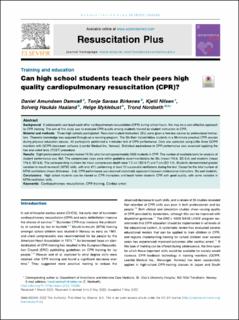| dc.contributor.author | Damvall, Daniel Amundsen | |
| dc.contributor.author | Birkenes, Tonje Søraas | |
| dc.contributor.author | Nilsen, Kjetil | |
| dc.contributor.author | Haaland, Solveig Haukås | |
| dc.contributor.author | Myklebust, Helge | |
| dc.contributor.author | Nordseth, Trond | |
| dc.date.accessioned | 2023-01-24T14:54:04Z | |
| dc.date.available | 2023-01-24T14:54:04Z | |
| dc.date.created | 2022-08-29T12:44:14Z | |
| dc.date.issued | 2022 | |
| dc.identifier.citation | Resuscitation Plus. 2022, 10 . | en_US |
| dc.identifier.issn | 2666-5204 | |
| dc.identifier.uri | https://hdl.handle.net/11250/3045950 | |
| dc.description.abstract | Background
If adolescents can teach each other cardiopulmonary resuscitation (CPR) during school hours, this may be a cost-effective approach to CPR training. The aim of this study was to evaluate CPR quality among students trained by student instructors in CPR.
Material and methods
Three high schools participated. Recruited student instructors (SIs) were given a two-day course by professional instructors. Theoretic knowledge was acquired through an e-learning program. The SIs then trained fellow students in a 90-minute practical CPR session during physical education classes. All participants performed a 4-minutes test of CPR performance. Data was collected using Little Anne QCPR manikins with QCPR classroom software (Laerdal Medical Inc, Norway). Statistical equivalence in CPR performance was assessed applying the two one-sided tests (TOST)-procedure.
Results
Eight professional instructors trained 76 SIs who trained approximately 2650 students in CPR. The number of available tests for analysis of student performance was 982. The compression rates were within guideline recommendations for SIs (mean 110.6, SD 5.4) and students (mean 118.6, SD 8.6). The corresponding numbers for mean compression depth were 7.2 cm (SD 0.7) and 7 cm (SD 1.0). Students demonstrated greater variation in mouth-to-mouth (MTM) skills, with only 41% performing at least 15 successful ventilations during the test. Except for the total number of MTM ventilations (mean difference −5.6), CPR performance was deemed statistically equivalent between professional instructors, SIs and students.
Conclusions
High school students can be trained as CPR instructors and teach fellow students CPR with good quality, with some variation in MTM-ventilation skills. | en_US |
| dc.language.iso | eng | en_US |
| dc.publisher | Elsevier | en_US |
| dc.rights | Navngivelse 4.0 Internasjonal | * |
| dc.rights.uri | http://creativecommons.org/licenses/by/4.0/deed.no | * |
| dc.title | Can high school students teach their peers high quality cardiopulmonary resuscitation (CPR)? | en_US |
| dc.title.alternative | Can high school students teach their peers high quality cardiopulmonary resuscitation (CPR)? | en_US |
| dc.type | Peer reviewed | en_US |
| dc.type | Journal article | en_US |
| dc.description.version | publishedVersion | en_US |
| dc.source.pagenumber | 0 | en_US |
| dc.source.volume | 10 | en_US |
| dc.source.journal | Resuscitation Plus | en_US |
| dc.identifier.doi | 10.1016/j.resplu.2022.100250 | |
| dc.identifier.cristin | 2046693 | |
| cristin.ispublished | true | |
| cristin.fulltext | original | |
| cristin.qualitycode | 1 | |

